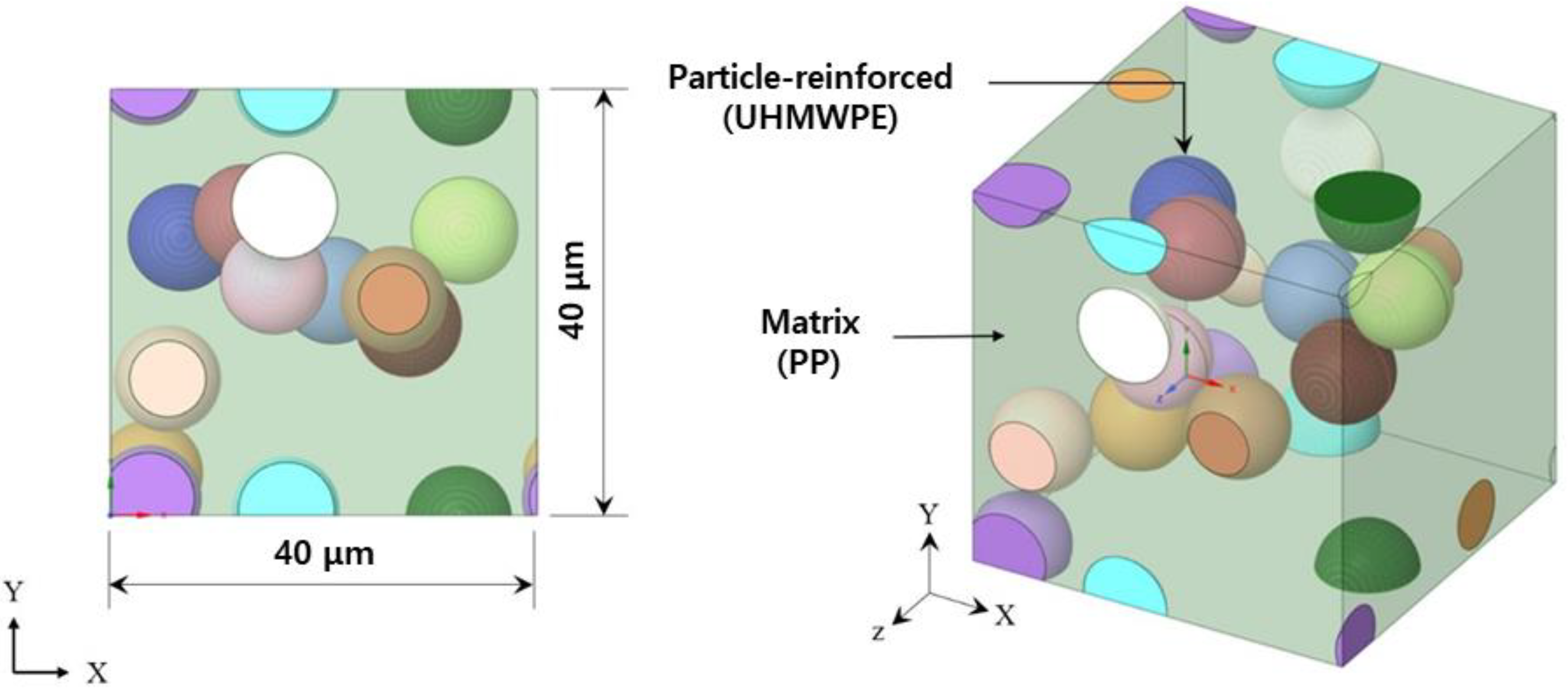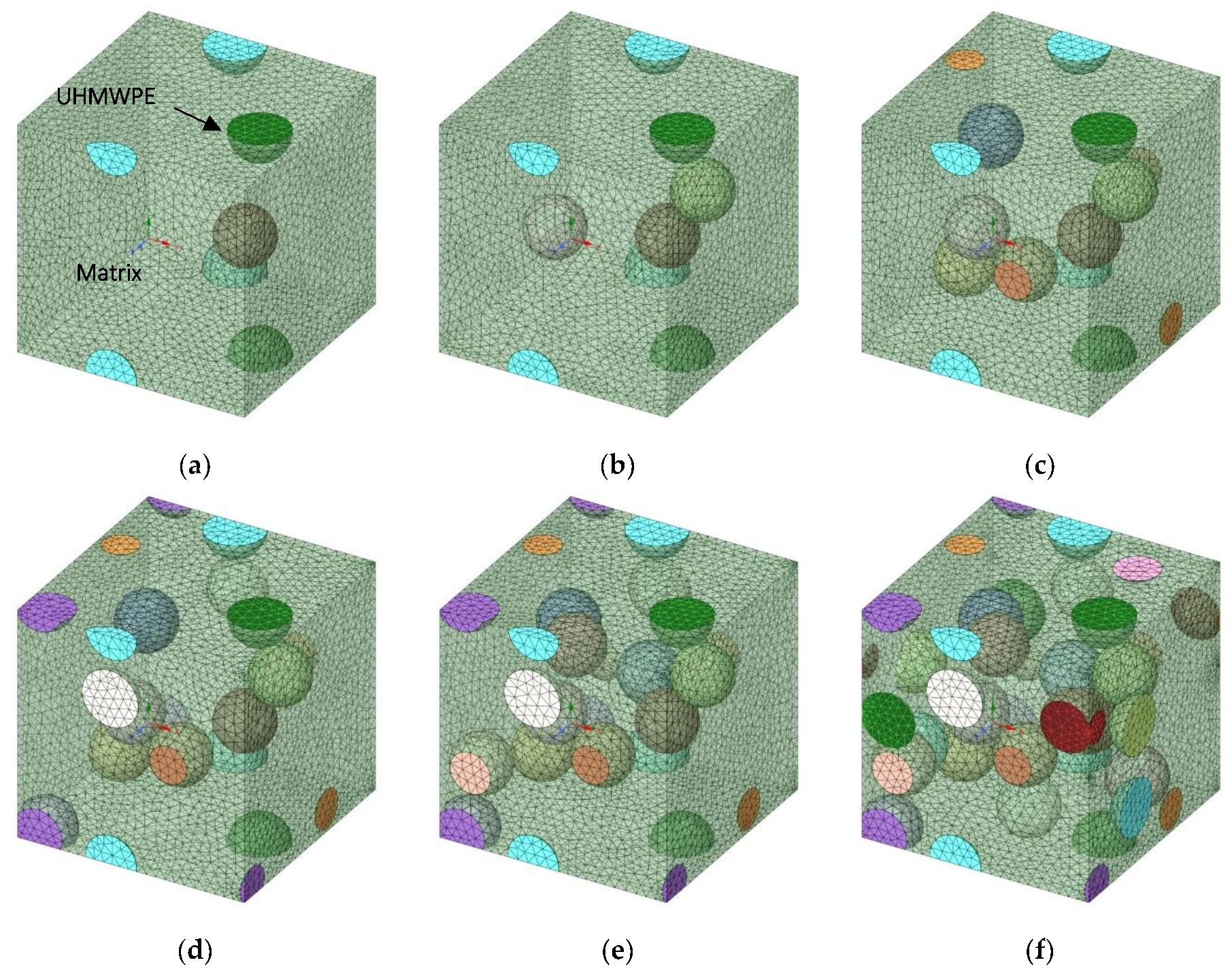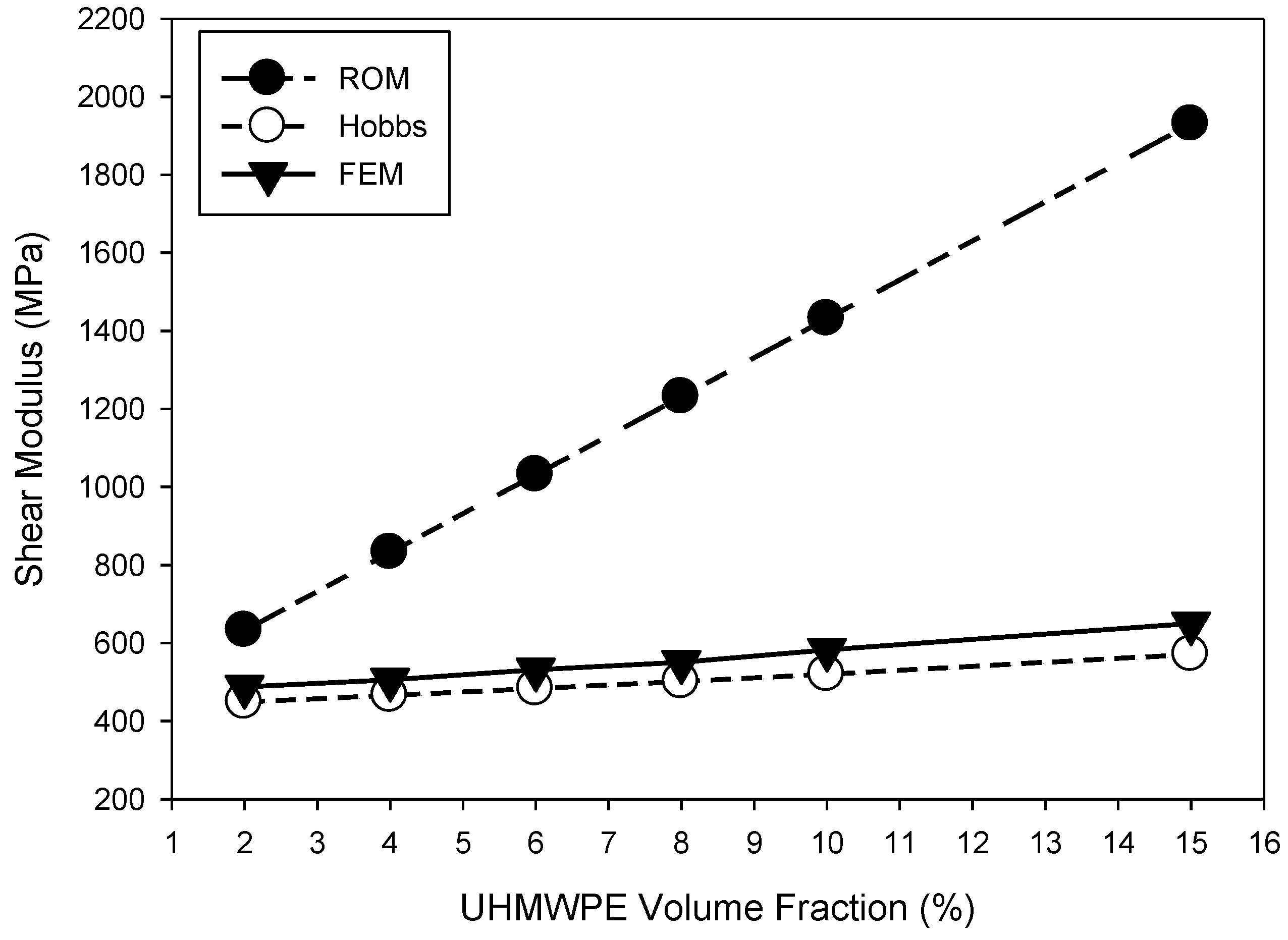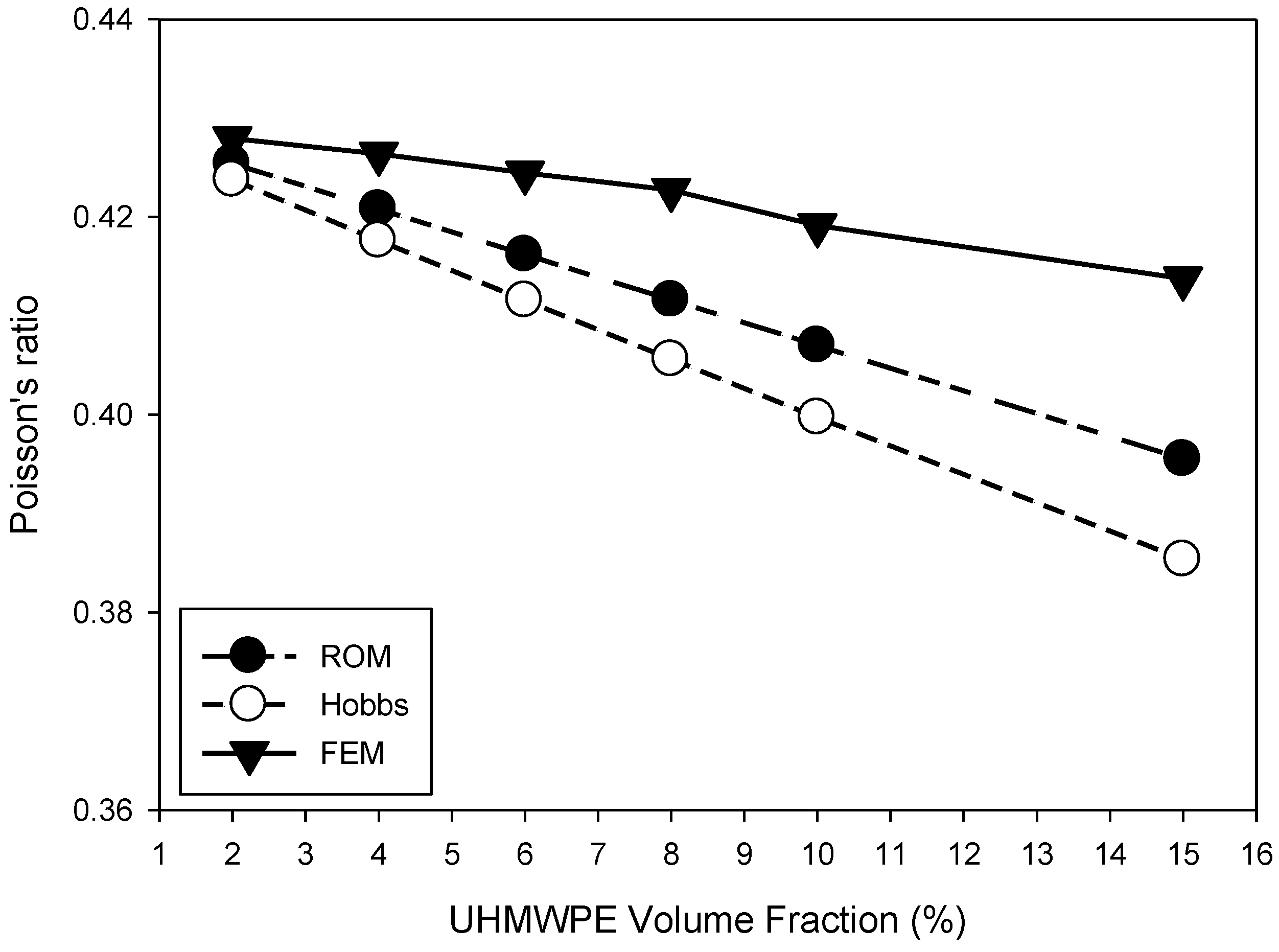Prediction of the Elastic Properties of Ultra High Molecular-Weight Polyethylene Particle-Reinforced Polypropylene Composite Materials through Homogenization
Abstract
:1. Introduction
2. Numerical Analysis Model
- ;
- ;
- ;
- ;
- .
3. Homogenization Method
4. Results
5. Conclusions
- (1)
- The elastic properties predicted using the ROM model according to the volume fraction of each material showed large errors;
- (2)
- The elastic properties predicted based on the Hobbs equation were similar to those obtained using the FEM, and the change trends of the elastic properties according to the volume fraction were also similar between the two sets of results;
- (3)
- In the prediction of the elastic properties with an isotropic composite prepared using reinforcement material with a spherical shape or in the form of a fine powder, the Hobbs equation produced results with a more similar trend to the FEA results than the ROM model did, and the former method is more appropriate for applications involving isotropic composite materials.
Author Contributions
Funding
Conflicts of Interest
References
- Zhao, X.; Li, Y.; Chen, W.; Li, S.; Zhao, Y.; Du, S. Improved fracture toughness of epoxy resin reinforced with polyamide 6/graphene oxide nanocomposites prepared via in situ polymerization. Compos. Sci. Technol. 2019, 171, 180–189. [Google Scholar] [CrossRef]
- Kavimani, V.; Prakash, K.S.; Thankachan, T.; Udayakumar, R. Synergistic improvement of epoxy derived polymer composites reinforced with graphene oxide (GO) plus titanium dioxide (TiO2). Compos. Part B Eng. 2020, 191, 107911. [Google Scholar] [CrossRef]
- Silva-Leyton, R.; Quijada, R.; Bastías, R.; Zamora, N.; Olate-Moya, F.; Palza, H. Polyethylene/graphene oxide composites toward multifunctional active packaging films. Compos. Sci. Technol. 2019, 184, 107888. [Google Scholar] [CrossRef]
- Prasob, P.A.; Sasikumar, M. Viscoelastic and mechanical behaviour of reduced graphene oxide and zirconium dioxide filled jute/epoxy composites at different temperature conditions. Mater. Today Commun. 2019, 19, 252–261. [Google Scholar]
- Guan, D.; He, X.; Zhang, R.; Qu, X. Microstructure and tensile properties of in situ polymer-derived particles reinforced steel matrix composites produced by powder metallurgy method. Mater. Sci. Eng. A 2017, 705, 231–238. [Google Scholar] [CrossRef]
- Zhou, Y.; Chen, B.; Wang, X.; Yan, C. Mechanical properties of Ti3SiC2 particulate reinforced copper prepared by hot pressing of copper coated Ti3SiC2 and copper powder. Mater. Sci. Technol. 2004, 20, 661–665. [Google Scholar] [CrossRef]
- Jose, A.S.; Athijayamani, A.; Jani, S.P. A review on the mechanical properties of bio waste particulate reinforced polymer composites. Mater. Today Proc. 2021, 37, 1757–1760. [Google Scholar] [CrossRef]
- Yadav, R.; Meena, A. Mechanical and two-body wear characterization of micro-nano ceramic particulate reinforced dental restorative composite materials. Polym. Compos. 2022, 43, 467–482. [Google Scholar] [CrossRef]
- Khan, S.U.; Kim, J.K. Impact and delamination failure of multiscale carbon nanotube-fiber reinforced polymer composites: A review. Int. J. Aeronaut. Space Sci. 2011, 12, 115–133. [Google Scholar] [CrossRef] [Green Version]
- Alexopoulos, N.D.; Bartholome, C.; Poulin, P.; Marioli-Riga, Z. Structural health monitoring of glass fiber reinforced composites using embedded carbon nanotube (CNT) fibers. Compos. Sci. Technol. 2010, 70, 260–271. [Google Scholar] [CrossRef]
- Liu, Y.; Kumar, S. Polymer/carbon nanotube nano composite fibers–a review. ACS Appl. Mater. Interfaces 2014, 6, 6069–6087. [Google Scholar] [CrossRef]
- Rawat, P.; Singh, K.K. An impact behavior analysis of CNT-based fiber reinforced composites validated by LS-DYNA: A review. Polym. Compos. 2017, 38, 175–184. [Google Scholar] [CrossRef] [Green Version]
- Van de Werken, N.; Tekinalp, H.; Khanbolouki, P.; Ozcan, S.; Williams, A.; Tehrani, M. Additively manufactured carbon fiber-reinforced composites: State of the art and perspective. Addit. Manuf. 2020, 31, 100962. [Google Scholar] [CrossRef]
- Wang, B.; Ma, S.; Yan, S.; Zhu, J. Readily recyclable carbon fiber reinforced composites based on degradable thermosets: A review. Green Chem. 2019, 21, 5781–5796. [Google Scholar] [CrossRef]
- Ko, Y.S.; Forsman, W.C.; Dziemianowicz, T.S. Carbon fiber-reinforced composites: Effect of fiber surface on polymer properties. Polym. Eng. Sci. 1982, 22, 805–814. [Google Scholar] [CrossRef]
- Khan, S.U.; Li, C.Y.; Siddiqui, N.A.; Kim, J.K. Vibration damping characteristics of carbon fiber-reinforced composites containing multi-walled carbon nanotubes. Compos. Sci. Technol. 2011, 71, 1486–1494. [Google Scholar] [CrossRef]
- Kurtz, S.M. A Primer on UHMWPE. In UHMWPE Biomaterials Handbook; Elsevier: Amsterdam, The Netherlands, 2016. [Google Scholar]
- Wright, T.M.; Goodman, S.B. (Eds.) Implant Wear: The Future of Total Joint Replacement; USA American Academy of Orthopaedic Surgeons: Rosemont, IL, USA, 1996; pp. 1–27. [Google Scholar]
- Bracco, P.; Bellare, A.; Bistolfi, A.; Affatato, S. Ultra-high molecular weight polyethylene: Influence of the chemical, physical and mechanical properties on the wear behavior: A review. Materials 2017, 10, 791. [Google Scholar] [CrossRef] [PubMed]
- Huang, W.; Wang, Y.; Xia, Y. Statistical dynamic tensile strength of UHMWPE-fibers. Polymer 2004, 45, 3729–3734. [Google Scholar] [CrossRef]
- Arazi, Z.S.; Harel, H.; Marom, G. Polyethylene/polyethylene composite materials for ballistic protection. SAMPE J. (USA) 1997, 33, 72–75. [Google Scholar]
- Zee, R.H.; Hsieh, C.Y. Energy absorption processes in fibrous composites. Mater. Sci. Eng. A 1998, 246, 161–168. [Google Scholar] [CrossRef]
- Manchiraju, V.N.M.; Bhagat, A.; Dwivedi, V.K. Prediction of elastic properties of unidirectional carbon/carbon composites using analytical and numerical homogenisation methods. Adv. Mater. Processing Technol. 2021, 1–15. [Google Scholar] [CrossRef]
- Mansor, M.R.; Sapuan, S.M.; Zainudin, E.S.; Nuraini, A.A.; Hambali, A. Stiffness prediction of hybrid kenaf/glass fiber reinforced polypropylene composites using rule of mixtures (ROM) and rule of hybrid mixtures (RoHM). J. Polym. Mater. 2013, 30, 321–334. [Google Scholar]
- Young, B.A.; Fujii, A.M.; Thiele, A.M.; Kumar, A.; Sant, G.; Taciroglu, E.; Pilon, L. Effective elastic moduli of core-shell-matrix composites. Mech. Mater. 2016, 92, 94–106. [Google Scholar] [CrossRef]
- Bary, B.; Haha, M.B.; Adam, E.; Montarnal, P. Numerical and analytical effective elastic properties of degraded cement pastes. Cem. Concr. Res. 2009, 39, 902–912. [Google Scholar] [CrossRef]
- Huang, J.; Krabbenhoft, K.; Lyamin, A.V. Statistical homogenization of elastic properties of cement paste based on X-ray microtomography images. Int. J. Solids Struct. 2013, 50, 699–709. [Google Scholar] [CrossRef] [Green Version]
- Bernard, O.; Ulm, F.J.; Lemarchand, E. A multiscale micromechanics-hydration model for the early-age elastic properties of cement-based materials. Cem. Concr. Res. 2003, 33, 1293–1309. [Google Scholar] [CrossRef]
- Hu, C.; Li, Z. Micromechanical investigation of Portland cement paste. Constr. Build. Mater. 2014, 71, 44–52. [Google Scholar] [CrossRef]
- Lavergne, F.; Fraj, A.B.; Bayane, I.; Barthélémy, J.F. Estimating the mechanical properties of hydrating blended cementitious materials: An investigation based on micromechanics. Cem. Concr. Res. 2018, 104, 37–60. [Google Scholar] [CrossRef] [Green Version]
- Yu, P.; Duan, Y.H.; Chen, E.; Tang, S.W.; Wang, X.R. Microstructure-based fractal models for heat and mass transport properties of cement paste. Int. J. Heat Mass Transf. 2018, 126, 432–447. [Google Scholar] [CrossRef]





| Unit | 2% | 4% | 6% | 8% | 10% | 15% | |
|---|---|---|---|---|---|---|---|
| Node | Ea | 113,767 | 113,211 | 118,315 | 119,491 | 121,788 | 127,324 |
| Element | Ea | 79,752 | 79,468 | 82,908 | 83,584 | 85,213 | 88,649 |
| PP | UHMWPE | |
|---|---|---|
| Modulus of elasticity (MPa) | 1325 | 25,000 |
| Shear modulus (MPa) | 432.29 | 10,417 |
| Poisson’s ratio | 0.43 | 0.20 |
| Bulk modulus of elasticity (MPa) | 3154.8 | 13,889.0 |
| Density (kg/m3) | 904 | 950 |
| Model | Contents | Unit | 2% | 4% | 6% | 8% | 10% | 15% |
|---|---|---|---|---|---|---|---|---|
| ROM model | E11 | MPa | 1798.5 | 2272.0 | 2745.5 | 3219.0 | 3692.5 | 4876.3 |
| G11 | MPa | 632.0 | 831.7 | 1031.4 | 1231.1 | 1430.8 | 1930.0 | |
| nu12 | - | 0.43 | 0.42 | 0.42 | 0.41 | 0.41 | 0.40 | |
| Hobbs equation | E11 | MPa | 1373.5 | 1423.9 | 1476.2 | 1530.4 | 1586.9 | 1738.2 |
| G11 | MPa | 448.5 | 465.3 | 482.8 | 501.0 | 519.9 | 570.8 | |
| nu12 | - | 0.42 | 0.42 | 0.41 | 0.41 | 0.40 | 0.39 |
| Model | Contents | Unit | 2% | 4% | 6% | 8% | 10% | 15% |
|---|---|---|---|---|---|---|---|---|
| FEM | E11 | MPa | 1392.80 | 1439.30 | 1519.50 | 1572.80 | 1661.90 | 1851.70 |
| E22 | MPa | 1396.60 | 1458.20 | 1538.10 | 1600.30 | 1685.70 | 1882.60 | |
| E33 | MPa | 1392.80 | 1439.30 | 1515.60 | 1570.10 | 1670.80 | 1865.40 | |
| G12 | MPa | 487.06 | 506.20 | 532.20 | 550.73 | 582.11 | 644.55 | |
| G23 | MPa | 487.24 | 504.67 | 528.38 | 547.80 | 577.89 | 648.52 | |
| G31 | MPa | 488.16 | 505.43 | 535.16 | 554.68 | 587.48 | 657.72 | |
| nu12 | 0.43 | 0.42 | 0.42 | 0.41 | 0.42 | 0.41 | ||
| nu13 | 0.43 | 0.43 | 0.43 | 0.43 | 0.42 | 0.42 | ||
| nu23 | 0.43 | 0.43 | 0.42 | 0.42 | 0.42 | 0.41 |
Publisher’s Note: MDPI stays neutral with regard to jurisdictional claims in published maps and institutional affiliations. |
© 2022 by the authors. Licensee MDPI, Basel, Switzerland. This article is an open access article distributed under the terms and conditions of the Creative Commons Attribution (CC BY) license (https://creativecommons.org/licenses/by/4.0/).
Share and Cite
Yun, J.-H.; Jeon, Y.-J.; Kang, M.-S. Prediction of the Elastic Properties of Ultra High Molecular-Weight Polyethylene Particle-Reinforced Polypropylene Composite Materials through Homogenization. Appl. Sci. 2022, 12, 7699. https://doi.org/10.3390/app12157699
Yun J-H, Jeon Y-J, Kang M-S. Prediction of the Elastic Properties of Ultra High Molecular-Weight Polyethylene Particle-Reinforced Polypropylene Composite Materials through Homogenization. Applied Sciences. 2022; 12(15):7699. https://doi.org/10.3390/app12157699
Chicago/Turabian StyleYun, Jong-Hwan, Yu-Jae Jeon, and Min-Soo Kang. 2022. "Prediction of the Elastic Properties of Ultra High Molecular-Weight Polyethylene Particle-Reinforced Polypropylene Composite Materials through Homogenization" Applied Sciences 12, no. 15: 7699. https://doi.org/10.3390/app12157699
APA StyleYun, J.-H., Jeon, Y.-J., & Kang, M.-S. (2022). Prediction of the Elastic Properties of Ultra High Molecular-Weight Polyethylene Particle-Reinforced Polypropylene Composite Materials through Homogenization. Applied Sciences, 12(15), 7699. https://doi.org/10.3390/app12157699






